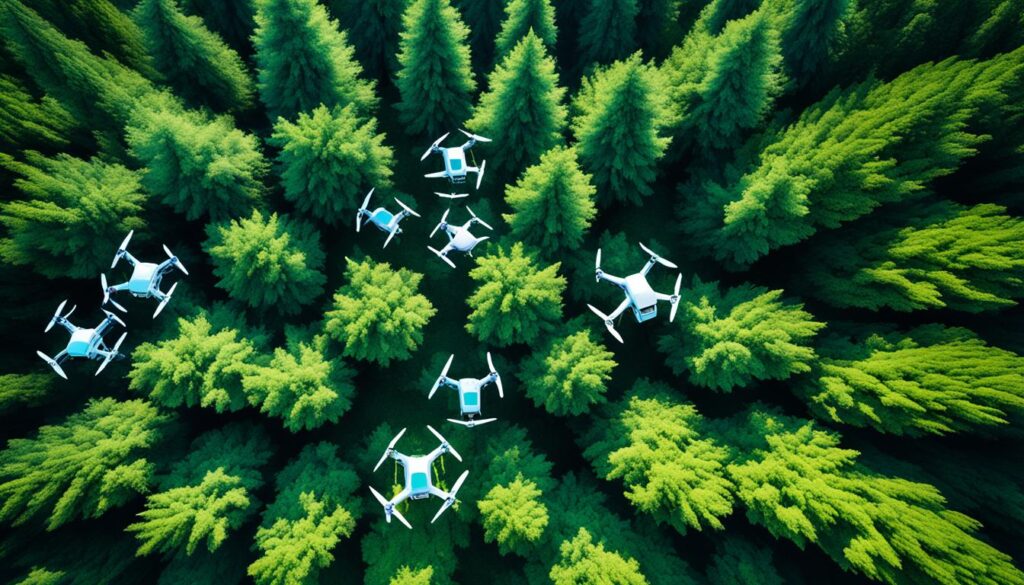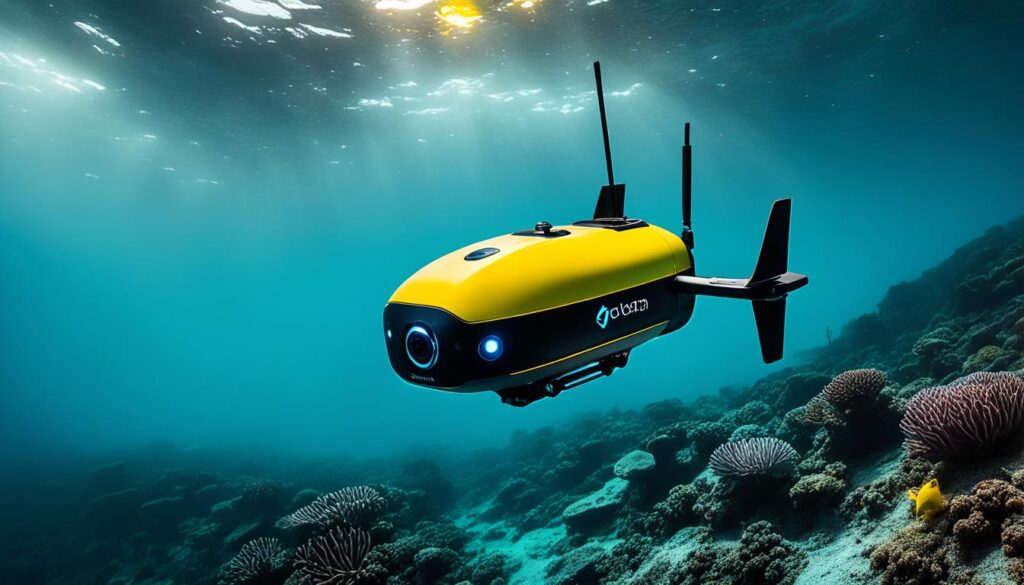Environmental challenges like climate change and losing biodiversity are growing. Technology, especially AI, is now key in fighting these issues. AI is changing how we manage resources and protect nature.
AI and environmental conservation are making new breakthroughs possible. AI helps us understand nature better and find new ways to protect it. This tech is showing us a brighter future for our planet.
This article looks at how AI helps in protecting the environment. We’ll see how AI is tackling big ecological problems. Let’s discover how AI can make our planet more sustainable.
AI and Sustainable Resource Management
AI technology is changing how we manage resources sustainably. Machine learning can look through lots of data to find patterns. These patterns help us tackle environmental issues before they get worse.
Machine Learning for Predictive Modeling
Machine learning helps create predictive models. These models can guess how much resources we’ll have, spot risks, and guide smart decisions. They use past data, current sensor info, and satellite images to understand our natural resources better.
Optimizing Renewable Energy Utilization
AI is key in making renewable energy better. It uses advanced analytics to boost how well renewable energy is made, stored, and sent out. This cuts down on waste and makes sustainable energy more effective.
AI helps with predicting how to save resources and making renewable energy better. It’s becoming a big help in managing resources sustainably. With AI, we’re getting closer to a future where taking care of the environment and doing well economically go hand in hand.
Monitoring Biodiversity with AI
Keeping the Earth’s diverse life forms safe is crucial for our planet. Thanks to AI, we’re now better at watching over and protecting wildlife. AI tools like computer vision and deep learning help us spot different species automatically. This makes monitoring nature more thorough and efficient.
Automated Species Identification
AI is changing how we track wildlife by making species recognition automatic. By learning from lots of images and sounds, AI can spot many plants and animals. This is super helpful for finding animals that hide well or are hard to see. It gives us a clearer view of nature’s health and variety.
AI has many uses in tracking nature, like following endangered animals or catching poachers quickly. As AI gets better, it’s becoming a key tool for protecting our natural world. It helps us keep the Earth’s valuable nature safe for the future.
Combating Deforestation with Technology
Deforestation is a big problem, but technology is helping us fight it. AI and remote sensing give us tools to watch over and save our forests. By using AI for deforestation prevention, we can greatly help protect our planet’s important ecosystems.
Remote Sensing and Satellite Imagery Analysis
Technology fights deforestation with remote sensing and satellite imagery. AI can look at satellite data to spot changes in forests, find threats, and track deforestation. This lets us act early and save more forests.

Predictive Analytics for Forest Conservation
Technology doesn’t just monitor; it also predicts and prevents deforestation. Predictive analytics use machine learning to guess where deforestation might happen. This lets us act before it does and save forests.
Using AI for deforestation prevention, remote sensing for monitoring, and predictive models for conservation is changing how we protect forests. As technology gets better, we’ll see more new ways to fight deforestation.
AI-Driven Climate Change Mitigation
Artificial intelligence (AI) is now a key player in fighting climate change. It helps scientists understand climate patterns and find better ways to reduce emissions. AI also supports sustainable practices by cutting down on greenhouse gases.
AI uses predictive analytics to tackle climate change. It looks at lots of data from satellites, sensors, and past climate records. This helps make accurate predictions about the future climate. This info helps leaders make smart choices about building, resources, and getting ready for emergencies.
AI is also key in creating new climate solutions. For instance, AI helps manage renewable energy better, cutting down on waste and boosting efficiency. AI also makes smart grids and energy-saving buildings possible, which lowers emissions.
In environmental sustainability, AI watches over natural ecosystems. It tracks deforestation, ocean health, and wildlife numbers. With AI, experts can make better decisions on protecting the environment.
As we face climate change, AI’s role in saving the environment will grow. By using this technology, we can aim for a future that’s good for our planet.
Technology for Waste Reduction and Recycling
Managing waste sustainably is key for our planet. Luckily, AI and smart tech are changing how we handle waste and recycling. They bring us closer to a circular economy with their smart waste systems and AI-powered sorting.
Smart Waste Management Systems
AI-driven smart waste systems are changing waste collection and disposal. They use learning algorithms to plan routes, track waste, and predict needs. This makes waste management more efficient and saves money.
These systems can predict when waste will pile up and adjust schedules. This cuts down on extra trips and lessens emissions.
AI-Powered Recycling Sorting Solutions
Sorting waste correctly is key to recycling, and AI is making it better. AI helps sort recyclables with great accuracy. It uses computer vision and learning to tell different materials apart.
This means more valuable resources get sorted right, making recycling better. AI is a big step towards a greener future. It helps us reduce waste, increase recycling, and aim for a circular economy.
Protecting Marine Ecosystems with AI
Our oceans are crucial for the planet’s health. AI tools help monitor marine ecosystems. They track water quality, biodiversity, and human impact. This lets us make better decisions and protect the oceans more effectively.
Automated Monitoring of Ocean Health
AI is changing how we check and protect our oceans. It uses sensors, satellite images, and learning machines. This way, scientists can track many indicators of ocean health.
AI helps us see patterns and trends in ocean data. This means we can quickly spot threats like oil spills or pollution. AI helps us make better policies and manage resources sustainably.

AI is key in protecting our oceans. It helps us make smart decisions and take action. With AI, we can work towards a better future for our oceans.
AI in Wildlife Conservation Efforts
Protecting endangered species and stopping poaching are key to saving our environment. AI technology is helping us find new ways to tackle these issues. It’s being used to make predictive models that help stop poaching before it happens. This lets conservation teams use their resources better and keep endangered animals safe.
Poaching Prevention with Predictive Models
AI-powered predictive models are changing wildlife conservation. They look at data from satellites, sensors, and past poaching to spot risky areas. This helps conservation teams set up patrols and stop poaching of animals like elephants, rhinos, and tigers.
Using AI for wildlife conservation has shown good results in tests worldwide. These models look at things like where animals live, how they move, and human activities. They send alerts in real-time, helping conservation teams act fast. This way, they can beat poachers before they strike.
AI and predictive analytics help conservationists make better decisions and use resources wisely. As AI gets better, we’ll see more progress in fighting poaching and saving our planet’s biodiversity.
The Future of Environmental Conservation and Technology
The future of environmental conservation looks bright, thanks to tech advancements. Experts see AI playing a big role, from monitoring ecosystems to creating sustainable energy solutions. This tech-conservation mix is key to tackling today’s environmental challenges.
AI is changing how we save the environment. It uses machine learning to analyze lots of data from satellites and sensors. This helps us make better decisions, like using renewable energy, fighting deforestation, and tracking wildlife.
Technology and sustainability will work closer together in the future. We’ll see smart waste systems and AI in recycling. Predictive analytics and remote sensing will also help protect forests and oceans.
Dealing with climate change and environmental harm will rely more on tech and green practices. AI can help us make big strides towards a sustainable future. It’s a powerful tool for our planet’s well-being.
Addressing Ethical Concerns in AI for Environmental Applications
AI technology is changing how we protect the environment. It’s important to think about the ethical issues that come with it. We need to make sure these technologies are developed in a responsible and transparent way. This ensures they help the environment and do good for everyone.
One big worry is bias in AI systems. Developers must watch out for biases that could affect how the algorithms make decisions. This could lead to bad outcomes or unfair effects on some groups. Having humans check on these systems and diverse teams designing them can lead to fairer results.
Privacy and data security are also big concerns when using AI for the environment. When we collect data like satellite images or monitor wildlife, we must protect people’s privacy. Being open about how we use data and having strong rules for data management can help people trust these technologies more.






